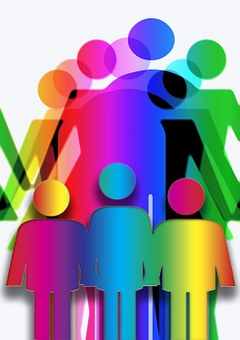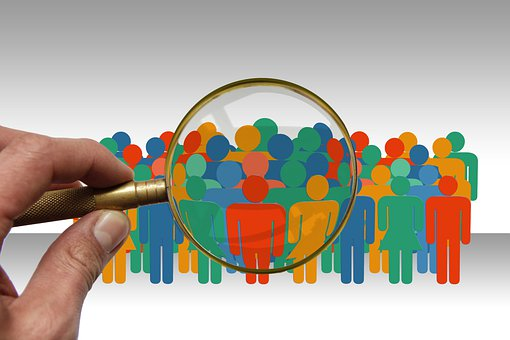1.2 What Is Sociology
We will start our exploration of sociological concepts by asking the question: What is sociology? Have you ever looked around and noticed patterns in social behavior? Have you wondered why some things are labeled normal, and some are not? Have you thought about why some groups of people treat each other differently? Or do you wonder why toy advertisements appeal to either boys or girls but rarely to both? Asking those questions is a crucial part of sociology. We can study everything we see around us related to people and institutions through the lens of sociology.
Sociology is the scientific and systematic study of groups and group interactions, societies, and social interactions. This study ranges from observing small and personal groups at the micro level to large groups and institutions at the macro level. A group of people who live in a defined geographic area, who interact with one another, and who share a common culture is what sociologists call a society.

Figure 1.2 busy city street, although we may assume these people have little in common, they are part of the same society and share many pieces of a common culture.
Culture refers to the group’s shared practices, values, beliefs, and norms. Culture encompasses a group’s way of life, from routine, everyday interactions to the most essential aspects of group members’ lives. It includes everything produced by a society, including social rules.
Sociologists often study culture using the sociological imagination, which sociologist C. Wright Mills described as an awareness of the relationship between a person’s behavior and experience and the broader culture that shaped the person’s choices and perceptions. It’s a way of seeing our and other people’s behavior in relation to history and social structure.
The sociological imagination allows us to understand the relationship between how society influences us and how we influence society. Typically, people think of their experiences in individualistic terms, meaning they see the impact of their experiences on themselves rather than seeing experiences as shared. The sociological imagination points out that what we experience as individuals is connected to larger social patterns and contexts. In the United States, we often think of marriage as an individual choice influenced by feelings like love. However, marriage decisions are also influenced by whether one’s gender or sexual identity is deemed acceptable.
In this short video, you will learn more about C. Wright Mills’s concept of the sociological imagination. To understand and apply this perspective, you will learn how to distinguish between what he refers to as personal troubles and public issues (figure 1.2 watch this 5:58 video on the sociological imagination).
Figure 1.3. The sociological imagination is the idea that you can view society through the lens of connections between the personal and the social. This video illustrates these ideas through explanation as well as thorough examples to help you learn to apply the term, which you will do throughout this text.
Some sociologists study social facts—the laws, morals, values, religious beliefs, customs, fashions, rituals, and cultural rules that govern social life—that may contribute to changes in the family. Have people in the United States viewed marriage and family differently over the years? Do they view them differently than people in Peru? Do employment and economic conditions play a role in families? Sociologists study the consequences of these new patterns, such as how children influence and are influenced by the changing needs for education, housing, and healthcare.
Sociologists identify and study patterns related to all kinds of contemporary social issues. The stop-and-frisk policy, the emergence of new political factions, and the way Twitter influences everyday communication are all examples of topics explored by sociologists.
1.2.1 Studying Part and Whole
A vital component of the sociological perspective is the idea that the individual and society are inseparable. It is impossible to study one without the other. German sociologist Norbert Elias called it figuration—the process of looking at the behavior of individuals and the society that shapes that behavior. In simpler terms, figuration means that as one studies social institutions, the individuals using that institution must also be “figured” into the analysis.
Consider religion. While people practice religion in a distinctly individual manner, religion exists in a larger social context as a social institution, a large-scale social arrangement that is stable and predictable, created and maintained to serve the needs of society. Social institutions are mechanisms or patterns of social order focused on meeting social needs, such as government, economy, education, family, healthcare, and religion. Within these institutional spaces, rules, norms, and procedures limit what actions are possible.
For instance, an individual’s religious practice may be influenced by what the government dictates, holidays, teachers, places of worship, rituals, and so forth. These influences underscore the relationship between individual practices of religion and social pressures that influence that religious experience (Elias, 1978). Think of current events, politicians, and conversations in our government and legal systems. The U.S. Constitution provides for the separation of church and state. Yet, many local and national government practices revolve around the Christian faith, like the concept of when life begins or the use of the Bible to swear someone into a political office (figure 1.2).

Figure 1.4 The continued influence of Christianity is shown here through elected officials swearing an oath on the Bible, even when our Constitution requires a separation of church and state.
A social structure is a set of long-lasting social relationships, practices, and institutions that can be difficult to see at work in our daily lives. However, they work the same way as structures we can see, like buildings and skeletal systems. The human body is made up of bones, which provide the structure for our internal organs and nervous systems. Structures limit possibility, but they are not fundamentally unchangeable. Just like our bones may deteriorate over time, suffer acute injuries, or be affected by disease, they never spontaneously change location or disappear into thin air. Such is the way with social structures.
1.2.2 Studying Patterns
All sociologists are interested in the experiences of individuals and how interactions with social groups and society shape those experiences. To a sociologist, an individual’s personal decisions do not exist in a vacuum. Cultural patterns, social forces, and influences pressure people to make one choice over another. Sociologists try to identify these general patterns by examining the behavior of large groups of people living in the same society and experiencing the same societal pressures.
Consider the changes in U.S. families over time. The “typical” family in past decades consisted of heterosexual married parents living in a home with unmarried children. Today, the percentage of unmarried couples, same-sex couples, blended families, and single-parent or single-adult households is increasing (see figure 1.5). Extended family members such as grandparents, cousins, or adult children living together in the family home are also on the rise. While 15 million mothers are single parents, 3.5 million fathers also raise their children alone (U.S. Census Bureau, 2020). Increasingly, single people and cohabitating couples choose to raise children outside of marriage through surrogacy or adoption.


Figure 1.5. Changing ideas of what families looks like in US society, on the left we see what is deemed “traditional family” and on the left a family with same sex/same gender parents.
By studying these types of patterns, we find trends and norms within a society. We can examine how societal expectations impact the family institution. Heteronormativity involves the everyday, taken-for-granted ways in which heterosexuality is privileged and normalized. For instance, sociologist Karen Martin studied what parents say to their children about sexuality and reproduction, and found that with children as young as three and five years old, parents routinely assumed their children were heterosexual, told them they would get (heterosexually) married, and interpreted cross-gender interactions between children as “signs” of heterosexuality (Martin, 2009).
This kind of socialization is an additional element of normative sexuality—the idea of compulsory monogamy, where exclusive romantic and sexual relationships and marriage are valued over other kinds of relationships (Willey 2016). Therefore, heteronormativity surrounds us at a very young age, teaching us that there are only two genders and that we are or should desire and partner with one person of the opposite gender, who we will marry. This is what sociologists call compulsory heterosexuality. “Compulsory heterosexuality is a term popularized by poet Adrienne Rich in her 1980 essay, “Compulsory Heterosexuality and Lesbian Existence.” Compulsory heterosexuality is a system of oppression that denies people’s sexual self-determination by presenting heterosexuality as the sole model of acceptable sexual and romantic relationship. Like other forms of social control, compulsory heterosexuality is a systemic problem, reinforced by interlocking institutions—including political, religious, economic, legal, medical, familial, and educational—that work in concert to maintain the privilege of man/woman heterosexual couplings and emotional pairings.
Though Rich described the ways lesbians and woman-identified values are threatened with erasure, compulsory heterosexuality coerces everyone, including straight people, who are expected to marry and reproduce”

Figure 1.6. LGBTQIA+ families and couples are faced with compulsory heterosexuality to marry and parent with someone of the opposite sex, but what we see in reality is many different makeups of couples and families.
These patterns of compulsory heterosexuality also play an important role in reproducing inequality in the lives of LGBTQIA+ people. For example, until a Supreme Court ruling in 2017, both same-sex spouses were not allowed to be listed on their child’s birth certificate in many states (Paven v. Smith, 2017). As of 2022, each state can still make its own laws about LGBTQIA+ discrimination in foster care, second-parent adoption, and parental presumption in same-sex relationships. Many states continue to explicitly allow discrimination within the foster care system and adoption placement or have no laws to prevent discrimination Image 1.6 shows variation in LGBTQIA+ families. Examples include:
- not requiring training for foster parents regarding LGBTQIA+ youth;
- not permitting second-parent adoptions for same-sex couples regardless of whether their relationship is legally recognized;
- laws permitting discrimination based on sexuality in adoption or foster placement.
Members of the LGBTQIA+ community have lost custody battles over children due to homophobia—the fear, hatred, or prejudice (Pershing, 1994). Media depictions of LGBTQIA+ people are few and often negatively stereotyped.
Sociological research shows us examples of how these social norms and patterns play out and change over time. Finding these patterns takes wide-ranging study and looking at past research to see what has changed and how, or what has not changed and why. This research is how we find patterns in the social structures and lived experiences of those in our society. This textbook will look at many different social patterns and topics using these lenses.
1.2.3 Sociology as an Evidence-Based Discipline
There is a common misconception that studying people, culture, and society is based on only experiences and opinions. Sociology is a scientific and evidence-based discipline, meaning that sociologists gather and use different forms of data to define and describe society. Like any other scientific field, sociology has strict codes of conduct, rigor, oversight of research, and validation of any statements made from research.
Sociology is a social science like anthropology, economics, political science, and psychology. All these disciplines use research to understand various aspects of human thought and behavior. When we say that sociology is a social science, we mean that it uses the scientific method to try to understand the many aspects of society. An important goal is to yield generalizations—general statements regarding trends of social life. Some generalization examples are: men are more likely than women to commit suicide, young people were more likely to vote for Biden than Trump in 2020, and so forth.
A generalization is a statement of a tendency rather than a hard-and-fast law. For example, the statement that men are more likely than women to commit suicide does not mean that every man commits suicide and no woman commits suicide. It means only that men have a higher suicide rate, even though most men do not commit suicide. Similarly, the statement that young people were more likely to vote for Biden than for Trump in 2020 does not mean that all young people voted for Biden; it only means that they were more likely to do so.
Many people will not fit the pattern of such a generalization because people are shaped but not totally determined by their social environment. That is both the fascination and the frustration of sociology. No matter how much sociologists can predict people’s behavior, attitudes, and life chances, many people will not fit the predictions. People can never be fully explained by their social environment, and sociologists can never completely understand the sources of their behavior, attitudes, and life chances.
In this sense, sociology is very different from a discipline such as physics, in which known laws exist for which no exceptions are possible. We call the law of gravity a law because it describes a physical force that exists on the earth at all times and in all places and always has the same result. If you were to pick up the pen near you and then let it go, the pen would fall to the ground. If you did this a second time, it would fall a second time. If you did this a billion times, it would fall a billion times. If your pen did not fall after being dropped, this instance would revolutionize our understanding of the physical world.
For better or worse, people are less predictable than gravity. Sociology can help us understand the social forces that affect our behavior, beliefs, and life chances, but it can only go so far toward such an understanding. However, it can help us comprehend who we are and what we are by helping us first understand the profound yet often subtle influence of our social backgrounds.
1.2.4 Scientific Method and Social Science
Although sociology as a discipline is very different from physics, it is not as different as one might think from the other “hard” sciences. Like these disciplines, sociology relies heavily on systematic research that follows the standard rules of the scientific method. As you probably learned in a science class, the scientific method involves these basic steps: (1) formulating a hypothesis, (2) measuring and gathering data to test the hypothesis, (3) analyzing these data, and (4) drawing appropriate conclusions. In following the scientific method, sociologists are no different from their colleagues in any other sciences, even though their research varies in other aspects (figure 1.7.

Figure 1.7 although social sciences don’t use microscopes and lab tests for research, there are many steps to insuring it is a scientific method with people, culture, and societies under the magnifying glasses.
Suffice it to say that careful research is essential for a sociological understanding of people, social institutions, and society. We may arrive at an understanding from our own personal experiences and knowledge, but how do we know what we think we know without a more thorough wide ranging research based approach?
Our usual knowledge and understanding of social reality come from at least five sources: (a) personal experience; (b) common sense; (c) the media (including the internet); (d) “expert authorities,” such as teachers, parents, and government officials; and (e) tradition. These are all important sources of understanding how the world “works,” but at the same time, their value can often be very limited. These five things can vary and will not be interpreted the same by each individual. Think of your own family—married, divorced, foster, grandparents, siblings, single parent—this may lead you to believe that most families are the same or that most in the area are the same, and that likely isn’t true.
Most readers probably learned the scientific method in school. The scientific method is followed in the natural, physical, and social sciences to help yield the most accurate and reliable conclusions possible, especially ones free from bias or methodological errors. An overriding principle of the scientific method is that scientists should conduct research as objectively as possible. Researchers are often passionate about their work, but they must take care not to let the findings they expect to uncover affect how they do their research. They must not conduct their research in a manner that “helps” them achieve the results they expect to find. Such bias can happen unconsciously, and using the scientific method reduces the potential for this bias.
This bias potential is arguably more significant in the social sciences than in the natural and physical sciences. The political views of chemists and physicists typically do not affect how they perform experiments and interpret the outcomes. In contrast, researchers in the social sciences often have strong feelings about the topics they study. Their social and political beliefs may influence how they perform their research on these topics and how they interpret the results. Following the scientific method helps reduce this possible influence.
1.2.5 Licenses and Attributions for What Is Sociology
“What Is Sociology” by Heidi Esbensen is adapted from “1.1 What Is Sociology?” by Tonja R. Conerly, Kathleen Holmes, Asha Lal Tamang in Openstax Sociology 3e, which is licensed under CC BY 4.0. Access for free at https://openstax.org/books/introduction-sociology-3e/pages/1-1-what-is-sociology
Definition of social institutions is from “Society, Culture, and Social Institutions” by Lumen Learning, in Introduction to Sociology, which is licensed under CC BY 4.0.
Additions to “Sociology as a Social Science” is adapted from “Sociology as a Social Science” by University of Minnesota, in Sociology, which is licensed under CC BY-NC-SA 4.0.
Figuration definition is a key term from OpenStax Sociology 3e by Tonja R. Conerly, Kathleen Holmes, Asha Lal Tamang, which is licensed under CC BY 4.0.
Social Institution definition is from the Open Education Sociology Dictionary edited by Kenton Bell, which is licensed under CC BY-SA 4.0.
Social Structure definition and example is from “Conceptualizing Structures of Power” by Miliann Kang, Donovan Lessard, Laura Heston, and Sonny Nordmarken in An Introduction to Women, Gender, Sexuality Studies, which is licensed under CC BY 4.0.
Two paragraphs from “Studying Patterns” are from “Sex, Gender, and Sexuality” by Elizabeth B. Pearce in Contemporary Families 2e, which is licensed under CC BY 4.0.
Figure 1.2. “Sociological Imagination” by Sociology Live! is licensed under CC BY 3.0.
Figure 1.3. Photo by Brian Merrill is licensed under the Pixabay License.
Figure 1.4. “John Kitzhaber administers the oath of office to Oregon’s new adjutant general, Maj. Gen. Daniel R. Hokanson” by the Oregon National Guard is licensed under CC BY 2.0. Modifications: Cropped.

